Loo-loo cry: Sacajawea gets a plaque
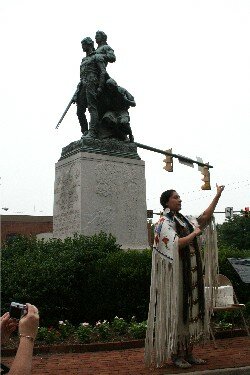 Sacajawea descendant Summer Morning Baldwin performs a traditional Shoshone sign language prayer at Friday's dedication.
Sacajawea descendant Summer Morning Baldwin performs a traditional Shoshone sign language prayer at Friday's dedication.PHOTO BY DAVE MCNAIR
Close to a hundred people gathered at the foot of the Lewis and Clark statue at the intersection of Ridge, Main, and McIntire Streets on Friday, June 19 in a ceremony dedicating a plaque to Sacajawea, the Shoshone woman who accompanied Meriwether Lewis and William Clark on the first American expedition to the Pacific coast.
Responding to concerns that Sacajawea's representation, crouched beneath the two men in bronze, underplayed her importance to the expedition, the City commissioned the plaque, and invited two of Sacajawea's descendents to author the text. The city also invited several of Sacajawea's descendents from Idaho to the afternoon ceremony.
"When I saw this statue I was very sad, but you are leading the way, Charlottesville," Rose Ann Abrahamson, Sacajawea's great-great-great niece, told the crowd. "I believe this expedition had divine intervention, because we are all here together."
Abrahamson's mother, the great-granddaughter of a powerful Shoshone medicine woman, then performed a "smudging" ceremony on the plaque with burning sage, lit by a match from a Hook reporter.
"This is so people will respect it," said Abrahamson, "and so it will always have positive energy."
Although portraying the expedition in a romantic style (including a stone base whose bas relief decoration recalls the flora of the Pacific Northwest), the 1919 statue by Charles Keck has entered the 21st Century as a painful reminder of oppression. Two years ago, for instance, some protesters put on a "Miss Informed" beauty contest.
The plaque ceremony included a brief prayer, during which Abrahamson's mother waved an eagle's wing to bless the crowd and the statue and asked the assembly to let out a traditional "loo-loo" cry.
The four generations of Sacajawea's descendents present included Summer Morning Baldwin, the daughter of Rozina George, a great-great-great grandaughter of Sacajawea's brother, Cameahwait, the "Great Chief" of the Lemhi Shoshones. George co-wrote the text on the plaque, using the preferred Lemhi Shoshone spelling of Sacajawea's name, and Baldwin performed a traditional flute solo and a Shoshone sign language prayer in ceremonial attire.
Members of Virginia's Monacan tribe were also present, led by Chief Kenneth Branham, who performed ceremonial dances. City leaders Mayor Dave Norris and preservation planner Mary Joy Scala, the latter of whom the Shoshone visitors credited with spearheading the plaque installation, were presented with traditional Shoshone coin purses.
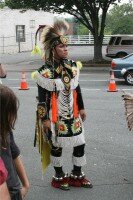
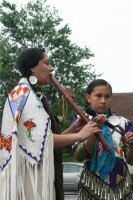
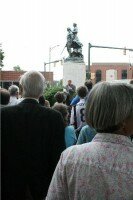
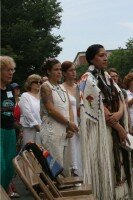
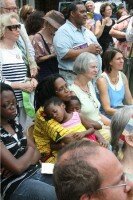



21 comments
No one asked here for equal billing. Just that the poor thing should get to at least stand up straight. A sense of humor would be useful. Such extremity in viewpoints on both sides seems like misspent energy.
All these commenters wanting to destroy a monument -- presumably it ain't happnin'. So how about lightening up, accepting what history has dealt us and moving forward in a productive, cooperative community spirit. Can't we all just get along?
But now that you mention it, I think the elephants should get TOP billing.
Admiral RE Peary manned a journey to the north pole, he was the brains behind the operation and now the politically correct revisionists want to give the credit to a black man because Admiral Peary had him carry the flag.
Lewis and Clark did not follow her like hunters following a bloodhound, they utilized her skills because she had them and was the best person available. She deservres credit and has received it. She is given significant credit in all the history books and that should be enough. This was a two man show with supporting characters not a three person show.
I am sure Edison and Einstein had assistants but they do not deserve acknowledgment beyond that.
Should Barnum and Bailey give the elephants equal billing?
Amazing to find people are opposed to clarifying this statue created by someone I would assume was WASP & before woman even had a right to vote. It is no wonder Sacajewea is placed below L&C and behind them...it was the mindset of the times.
Well people as Dylan would say 'times they are a-changin'.
Thanks for the laugh Ohplease!
Now who praytell would think that Sacajewea is studying the ground? No one thinks this the first time they see this stautue, they have to be told this. I would love to see it taken down, it is a blight to the crossroads of downtown. I cringe each time I see it! I have lived in C'ville for 26 years and never once have I heard a kind remark about this statue from any visitor. I know, let's put up a sigh that says "she is studying the trail so they can find their way!" Let's make it big and light it up at night so everyone will know.
A "a great-great-great grandaughter of Sacajawea’s brother" is neither an ancestor nor a descendant. Actually, if you read closely, none of them seem to actually be descendants, although it's hard to imagine what difference it would make if they were. Who can speak for someone he or she has never even met?
This is what happens when government gets into the art business.
The original statue, by Charles Keck a noted New York sculptor chosen by Paul McIntire, showed Sacajewea intently reading the ground, pathfinding for the expedition. It is graceful and harmonious.
But the forces of political correctness ordained a change. The plaque, chosen by bureaucrats, is butt-ugly. What's worse, some future hyper-sensitive person is going to complain Sacajewea is bowing her head as if in subservience.
Then we'll need a new plaque, this time with Sacajewea singlehandly striding across the continent while Lewis and Clark linger behind, sitting on a couch drinking beer scratching their bellies, and watching television.
The original article posted says "ancestors", I suspect it is people who claim to be her descendents - not her ancestors who were present.
I was horrified when I first saw the statue . I agree with LBJ2 that almost everyone would fail to see it as Sacajewea studying the ground. I saw it as demeaning to her as a wpman and a Native Ammerican.
If the city is sincere about the messages our statues portray, the time is long overdue to remove statues that celebrate the Confederacy. Germany and Italy took down fascist statues a long time ago.
Lewis and Clark were not the first whites to cross the Continent. The first was a Canadian named Alexander Mackenzie. Doubtless Sacajewea is peering down at his footprints left long before and thinking--"jeez somebody should put up a statue to this guy."
Babies rule the C-Ville world. Breed baby, breed.
I fixed the ancestor/descendant switcheroo early this morning. Thanks for letting us know of the gaffe.--hawes spencer, hook editor
I think it should be just Lewis and Clark on the statue. Just lop her off and touch up that side. I am sure she was a huge asset to the journey but she was not one of the leaders.
This article gives some interesting background on this debate: http://www.dailyprogress.com/cdp/news/local/article/experts_more_to_stat... .
There's no question Sacajawea was an afterthought to this statue; the article states that Charles Keck, the sculptor, assured the nominating committee that Sacajawea ââ?¬Å?does not compete with them in the composition.”
The 1919 article mentioned is in Google Books, and includes this: the statue "commemorates the moment when Lewis and Clark had their first view of the Pacific. They stand at gaze, with Sacajawea, the squaw guide and only woman of the party, bending forward, intent on the scene."
Nonsense, of course. Why depict her crouching at such a moment? Surely today it's a noncontroversial consensus that the sculptor, expressing the sexism that was then the norm, intentionally positioned her to indicate a lesser significance. I would have no patience with debating that point further with anyone.
The interesting question is what to do now. In recent years I've visited Italy, where intensely Christian cultures preserve countless images of their now-discarded mythical gods (well, one left to go). Some of these gods were pretty heinous. And England, which preserves ruins of their Roman enemies. The world is grateful for this broadmindedness, which allows us these glimpses into our past and the pleasure of human artistry through the ages, even when the subject matter is archaic.
Thus the world cried out in revulsion when Islamicists, believing it right to purge the past and "purify" the present, destroyed ancient Buddhist statues.
This facet of American history is less ancient, to be sure, but the philosophy remains. Rather than destroy and purge, I for one vastly prefer that we step up our education about the lessons learned from old icons and our creation of the next layer of built history worth preserving.
And what should that next layer be? Let's have a design contest for a new statue nearby. My unserious but rather enjoyable fantasy: Sacajawea, proudly upright, gazes in victory at the first distant sight of the ocean, one arm outspread to embrace the view, the other pointing the way forward. Lewis and Clark each face a different wrong direction, crouching with hands clapped to the their heads in lost confusion.
There were over 45 members of the Corps of Discovery. When do the rest of them get their plaques?
http://www.nps.gov/archive/jeff/LewisClark2/CorpsOfDiscovery/TheOthers/O...
Good Lord, are there only whiners left in this world?!
You know, Curtis, you're absolutely right. How silly of me to to walk into a kindergarten mudfight and expect thoughtful discourse. I'll exit and leave you kids. Do clean up when you're done.
From Bo:
"Good Lord, are there only whiners left in this world?!"
You are numbered among them.
Miss Feasance, reread Art Critic, including the sentence about "hypersensitive persons," and you'll see your views are actually diametrically opposed. That said, I agree with you about the image I would have preferred -- the Bismarck, ND statue, of which there's a photograph in the link I provided, is without a doubt far superior.
Hey, I agree with Art Critic. On the statue Sacajawea's paused, and pulled her long braids aside so she can look carefully and find the way. On the plaque she's just standing there smiling down at -- what? A basket of something? A baby? I mean, nothing against motherhood but talk about stereotypes. Give me an intrepid Sacajawea intent on exploring as against some smiling squaw with a basket, any day.
The plaque's depiction of Sacajawea is graceful and noble.
(Only "art critic" is ugly, whose lone, bitter digital graffiti should be disregarded).
The text of the plaque, not included in the article and difficult to make out in the picture, reads:
"This plaque is dedicated to Sacajawea, whose contribution of traditional and cultural knowledge, with courage and bravery, earned her recognition in the chronicles of American history.
Sacajawea was a Lemhi Shoshone (Agaidika) born in Salmon, Idaho, in 1788. She was the only female to travel on the long, arduous expedition with the Lewis and Clark Expedition (1805-1806).
Sacajawea served as an ambassador, bridging relations amongst nations. Her contribution to the people of today and of future generations can be identified as a symbol of unity and peace for all people."
She was an amazing human being. There's more fascinating information about her in the PBS article at http://www.pbs.org/lewisandclark/inside/saca.html .
(To The Hook Editor: do please fix the "ancestor/descendant" error in the top photo caption; it's distracting).